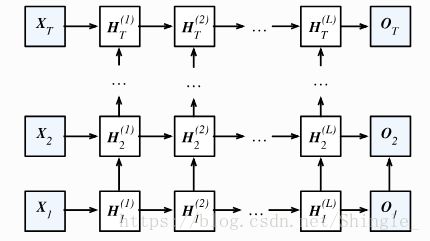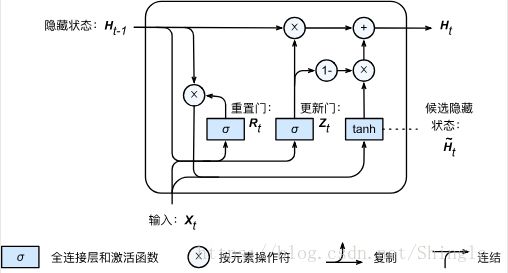RNN-LSTM-GRU
循环神经网络(Recurrent Neural Network, RNN)
假设 Xt∈Rn×d X t ∈ R n × d 是序列中时间步 t 的小批量输入 Ht∈Rn×h H t ∈ R n × h 该时间步的隐藏层变量。跟多层感知机不同在于这里我们保存上一时间步的隐藏变量 Ht−1 H t − 1 并引入一个新的权重参数 Whh∈Rh×h W h h ∈ R h × h ,它用来描述在当前时间步如何使用上一时间步的隐藏变量。具体来说,当前隐藏变量的计算由当前输入和上一时间步的隐藏状态共同决定:
这里隐藏变量捕捉了截至当前时间步的序列历史信息,就像是神经网络当前时间步的状态或记忆一样,因此也称之为隐藏状态。
def rnn(inputs, state, params):
# inputs 和 outputs 皆为 num_steps 个形状为(batch_size, vocab_size)的矩阵。
W_xh, W_hh, b_h, W_hy, b_y = params
H, = state
outputs = []
for X in inputs:
H = nd.tanh(nd.dot(X, W_xh) + nd.dot(H, W_hh) + b_h)
Y = nd.dot(H, W_hy) + b_y
outputs.append(Y)
return outputs, (H,)深度循环神经网络
双向循环神经网络
梯度裁剪
循环神经网络中较容易出现梯度衰减或爆炸,为了应对梯度爆炸,我们可以裁剪梯度(clipping gradient)。假设我们把所有模型参数梯度的元素拼接成一个向量 g,并设裁剪的阈值是 θ。裁剪后梯度的 L2 范数不超过 θ。:
def grad_clipping(params, theta, ctx):
norm = nd.array([0.0], ctx)
for param in params:
norm += (param.grad ** 2).sum()
norm = norm.sqrt().asscalar()
if norm > theta:
for param in params:
param.grad[:] *= theta / normhttp://zh.gluon.ai/chapter_recurrent-neural-networks/rnn-scratch.html
梯度裁剪可以解决梯度爆炸的问题,梯度衰减呢? -> 门控单元
LSTM
输入门、遗忘门和输出门:
候选记忆细胞:
记忆细胞:
隐藏状态:
def lstm(inputs, state, params):
[W_xi, W_hi, b_i, W_xf, W_hf, b_f, W_xo, W_ho, b_o, W_xc, W_hc, b_c,
W_hy, b_y] = params
(H, C) = state
outputs = []
for X in inputs:
I = nd.sigmoid(nd.dot(X, W_xi) + nd.dot(H, W_hi) + b_i)
F = nd.sigmoid(nd.dot(X, W_xf) + nd.dot(H, W_hf) + b_f)
O = nd.sigmoid(nd.dot(X, W_xo) + nd.dot(H, W_ho) + b_o)
C_tilda = nd.tanh(nd.dot(X, W_xc) + nd.dot(H, W_hc) + b_c)
C = F * C + I * C_tilda
H = O * C.tanh()
Y = nd.dot(H, W_hy) + b_y
outputs.append(Y)
return outputs, (H, C)GRU
重置门和更新门:
候选隐藏状态:
隐藏状态:
def gru(inputs, state, params):
W_xz, W_hz, b_z, W_xr, W_hr, b_r, W_xh, W_hh, b_h, W_hy, b_y = params
H, = state
outputs = []
for X in inputs:
Z = nd.sigmoid(nd.dot(X, W_xz) + nd.dot(H, W_hz) + b_z)
R = nd.sigmoid(nd.dot(X, W_xr) + nd.dot(H, W_hr) + b_r)
H_tilda = nd.tanh(nd.dot(X, W_xh) + R * nd.dot(H, W_hh) + b_h)
H = Z * H + (1 - Z) * H_tilda
Y = nd.dot(H, W_hy) + b_y
outputs.append(Y)
return outputs, (H,)http://www.tensorfly.cn/tfdoc/tutorials/recurrent.html
Recurrent Neural Network Regularization - Wojciech Zaremba, Ilya Sutskever, Oriol Vinyals https://arxiv.org/abs/1409.2329
https://github.com/tensorflow/models/tree/master/tutorials/rnn
Hochreiter, S., & Schmidhuber, J. (1997). Long short-term memory. Neural computation, 9(8), 1735-1780.
Cho, K., Van Merri ë nboer, B., Bahdanau, D., & Bengio, Y. (2014). On the properties of neural machine translation: Encoder-decoder approaches. arXiv preprint arXiv:1409.1259.
Chung, J., Gulcehre, C., Cho, K., & Bengio, Y. (2014). Empirical evaluation of gated recurrent neural networks on sequence modeling. arXiv preprint arXiv:1412.3555.
http://karpathy.github.io/2015/05/21/rnn-effectiveness/
http://deeplearning.net/tutorial/lstm.html#lstm
http://colah.github.io/posts/2015-08-Understanding-LSTMs/
https://distill.pub/2016/augmented-rnns/




